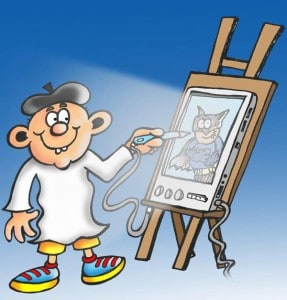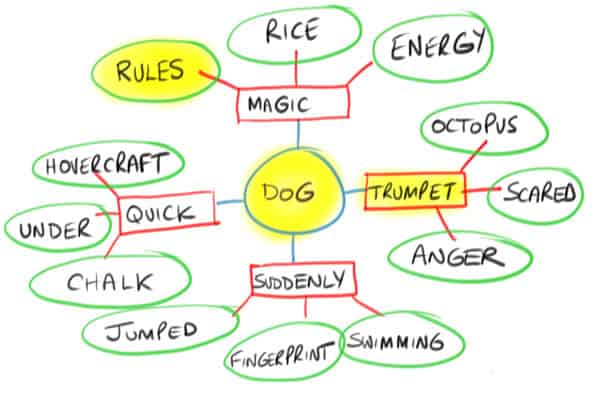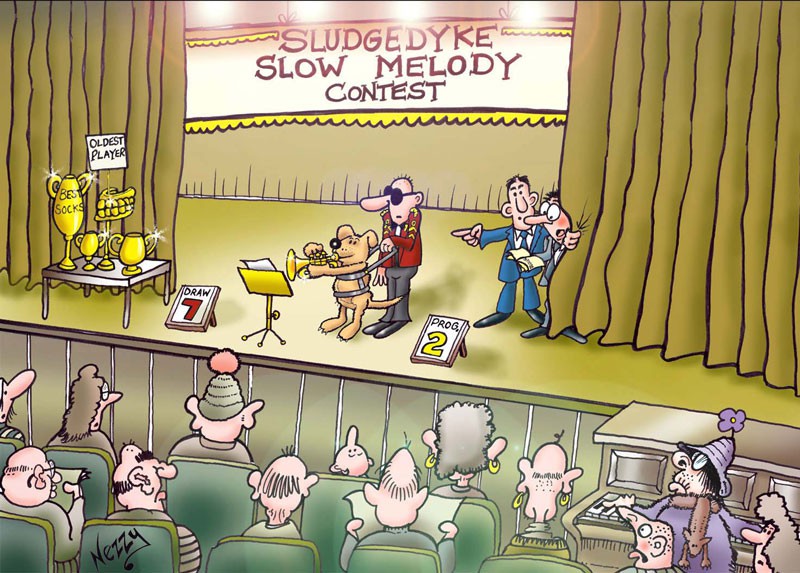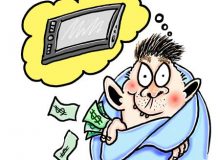How to become a cartoonist – ten vital tips
Cartoonist career information to put you on the right track
The following tips are the basic things you need to do and know to give yourself a great chance of becoming a professional cartoonist. If you really want to draw professionally you should have a system in place that will develop and keep you at the top of your game:
1. Set up a daily cartoon routine
Absolutely vital – if you can make yourself carry out a set drawing/ thinking/ researching routine it will quickly become a habit that lets you focus on what you do best – drawing. Set aside some time every day to draw or plan out and research your cartoons. If you have no work lined up create cartoons that can be used in the future or practice those areas that you need to brush up on such as perspective, hands and textures. You have to be disciplines in doing work every single day – eventually it will become a lifetime habit.
2. Motivation to draw
It can be difficult to drag the pens and pencils out. Creative minds often suffer from this problem but there are ways to overcome this dilemma. Keep a selection of books by the cartoonists you admire the most.
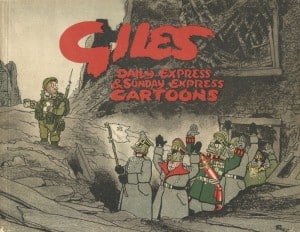 I have over 40 Giles annuals and a truck load of Gary Larson books to keep me inspired. Carl Giles in my opinion is the greatest ever cartoonist from the UK who produced thousands of cartoons for the Daily Express Newspaper. Gary Larson’s talent is immense and his ‘Far Side’ cartoons are really quirky and inspiring. If I get a low spot I simply thumb through these cartoons and the sheer brilliance of Giles, Larson and other greats of the cartooning world lift me back to a highly motivated state – ready to draw my socks off!
I have over 40 Giles annuals and a truck load of Gary Larson books to keep me inspired. Carl Giles in my opinion is the greatest ever cartoonist from the UK who produced thousands of cartoons for the Daily Express Newspaper. Gary Larson’s talent is immense and his ‘Far Side’ cartoons are really quirky and inspiring. If I get a low spot I simply thumb through these cartoons and the sheer brilliance of Giles, Larson and other greats of the cartooning world lift me back to a highly motivated state – ready to draw my socks off!
Another way is to set goals – either daily or weekly. I sit down each day with a blank sheet and map out what cartoons I have to do and those that I would like to do. I then target the have to do’s first and if time permits I will look at any other cartoons and cartoon planning and research.
 When you have a written ‘goal list’ in front of you it makes you stick the task in hand. To keep focussed I switch off all social media, e mail and and ban myself from Google (apart from research) then switch on a great free tool found at e.ggtimer.com which is an online alarm clock. This allows me to set chunks of time to each goal for the day.
When you have a written ‘goal list’ in front of you it makes you stick the task in hand. To keep focussed I switch off all social media, e mail and and ban myself from Google (apart from research) then switch on a great free tool found at e.ggtimer.com which is an online alarm clock. This allows me to set chunks of time to each goal for the day.
3. Recording your cartoon ideas

Waking up in the middle of the night with the best idea for a cartoon that you ever had is great but to then go back to sleep and wake up with that idea gone is terrible.
Always, always ALWAYS! have something on you or to hand that you can quickly jot down that flash of inspiration. either a spiral notepad, a voice/note taker on your mobile such as ‘Evernote’ (free app) or the best of both worlds is a Boogie Board Sync on which you can write, draw and save your ideas.

Whatever you do – never be without something you can capture that moment of your cartooning genius! I have spiral notebooks going back 30 years that I still use for reference even now. So every time you get an idea make sure you record it. It might be the very idea that makes or breaks your cartooning career!
4. Never say no to a cartoon request
When you are starting out on the trail to becoming a professional cartoonist take a tip from me. Never ever say no when asked to do a cartoon. Even if you get paid a pittance or even asked to do a freebie always take it on.
Doing work for others puts pressure on you to come up with the goods and you will be amazed at what you can produce. This for me was the best practice regime I could have had as people will ask for almost anything to be drawn. I have produced free work for the following projects:
- A design to go on a bus (the whole bus)
- A giant dolls house
- A fire service cartoon strip
- A Spanish Pub logo
- Rugby, football and squash team tour tee shirt designs
- Christmas and greetings cards
- Dragon on a school wall to cover up graffiti
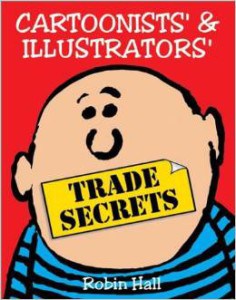 …plus hundreds of others. Am I mad for doing all this for free? Certainly not it was the best free drawing course I have ever taken with me acting as both student and teacher. The motivation was to produce a huge variety of work that enabled me to get better at what I was doing. It also opened my eyes to the myriad of artwork and art related products that you can get paid for. If you want to see a great book to give you plenty of ideas for creating and selling your cartoons take a look at Robin Hall’s – ‘Cartoonist’s and Illustrators Trade Secrets. This book is packed with ideas for different cartoon products and good sound advice on how to market your talents.
…plus hundreds of others. Am I mad for doing all this for free? Certainly not it was the best free drawing course I have ever taken with me acting as both student and teacher. The motivation was to produce a huge variety of work that enabled me to get better at what I was doing. It also opened my eyes to the myriad of artwork and art related products that you can get paid for. If you want to see a great book to give you plenty of ideas for creating and selling your cartoons take a look at Robin Hall’s – ‘Cartoonist’s and Illustrators Trade Secrets. This book is packed with ideas for different cartoon products and good sound advice on how to market your talents.
5. Study the work of other cartoonists
I was greatly influenced by many cartoonists and you can learn so much by just looking over their artistic shoulders. I have taken this quite a bit further buying up many original cartoon work of those I admire the most. The things I look at include:
- Layout
- Perspective
- Textures
- Captions
- Colors and shading
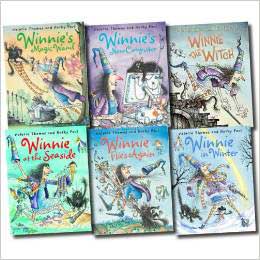 You can learn a great deal from others cartoonists work and the idea is not to copy their style verbatim but to adapt some ideas that you like (such as shading technique) using it to enhance your own style. The bottom line is to take but don’t copy. Some other great cartoonists that I admire are Charles Shultz (peanuts), and one of my favourites for detail is Korky Paul, an Australian artist who illustrates the Winnie the Witch children’s book series.
You can learn a great deal from others cartoonists work and the idea is not to copy their style verbatim but to adapt some ideas that you like (such as shading technique) using it to enhance your own style. The bottom line is to take but don’t copy. Some other great cartoonists that I admire are Charles Shultz (peanuts), and one of my favourites for detail is Korky Paul, an Australian artist who illustrates the Winnie the Witch children’s book series.
6. How you can overcome ‘cartoonists block’
I often get a lack of inspiration but have learned that it’s a waste of time grumbling about it and staring at an empty sheet of paper. I have developed several strategies for kick starting my creative imagination:
- I Keep a portfolio of my own work and use it to look back at when nothing is sparking my braincells.
- I keep a library of other cartoonists work to draw inspiration from.
My number 1 tool is my mind mapping strategy which has never failed to work every time. In fact I have produced some of my best work using this method. I start with a word in a circle in the middle of the page then pick another 4 words and place them in rectangles outside the centre word. From each rectangle i select another 3 words and place them in ovals.
After that I select the centre word, one from a rectangle and one from an oval. Then the fun begins. I have to come up with a cartoon scenario that uses all three word. As you can see I had:
DOG + TRUMPET + RULES
This is a real example that I used to create the cartoon below which I managed to have published in Brass band World Magazine. Obviously you don’t have to have random words if you are working in a particular subject and are stuck for an idea. this method is gold dust for me and I am sure if you use it you will find it invaluable as well.
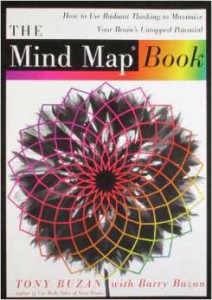 Mind maps are not just a great tool for cartoonists but can be used for almost everything including college studies – I passed a University project management degree using mind maps. If you would like to know more I highly recommend Tony Buzans incredible ‘The mind Map Book’ which details this superb way to learn and analyse
Mind maps are not just a great tool for cartoonists but can be used for almost everything including college studies – I passed a University project management degree using mind maps. If you would like to know more I highly recommend Tony Buzans incredible ‘The mind Map Book’ which details this superb way to learn and analyse
7. People are the best source for cartoonists inspiration
People are the funniest things on earth and all you have to do is watch and listen. Whether its a mannerism, a look, fashion, kids logic, or just stupid comments made in general conversation you can find material for cartoons. People are everywhere and its a free lesson with bags of material.
A great deal of my cartoon strip work was based upon observing and talking to people then adding my twist. I worked in Hackney London for about 4 years and there are small parks dotted amongst the sprawl of concrete high rise. I would take an hour out for lunch on a park bench and enjoy watching the world unfurl around me. I would not fail to get at least one idea per visit – a character, a pose someone taking their dog for a walk that looked like the dog or perhaps a goofy looking cyclist. Lot’s to draw! So never overlook the free human resource you have all around you.
8. Don’t be afraid to develop your cartoon style over time
As you develop your skills, pick up tips from others and observe the world over a period of time your drawing style will change. This is a natural progression and if at first you are not happy with your own personal cartoon style – don’t worry it can be changed for the better.
I look back at my early days and shudder when I see some of the obvious mistakes i had made. But through hard work and keeping my eyes open wide to new ideas and techniques I am now happy with the work I produce.
 9. Don’t be afraid of technology
9. Don’t be afraid of technology
There is nothing wrong with pencil, pen and ink and some cartoonists will not budge from it. I was that person until I discovered Photoshop Elements which opened up a new world. It didn’t take long to get to grips with the software and it has enabled me to speed up my cartoon work ten fold. It also allows the luxury of adding professional text to posters and other artwork that I could have only dreamed about a few years back.
More recently the advances in graphics drawing tablets is quite astounding, enabling you to create superb artwork without a brush, pen or ink in sight. The best part of digital art for me is that I can undo a mistake instantly which is not the case for conventional artwork. I have produced many articles and reviews on graphics drawing tablets which you can see with this link to the graphics tablet article index…
10. Get a cartoon track record that you can use for the future
When you are starting out it is usually difficult to get paid work. If you are chasing a cartoon spot in a magazine and get paid for it you may be handing around for a long time. I looked through various magazines and local publications to see if a cartoonist was being used. Initially I wrote in and offered my services but had no luck. Then I changes tack and offered my services free (here he goes again with his free cartoons I hear you say).
Well yes – it got me into a couple of magazines and from that I have managed to get paid spots in others. The initial freebies were a bit painful as it was all work and no pay. However the experience of working with an editor and actually getting your work published is not just a great feeling but is great training as well.
The other way to prepare for the future is to maintain an up to date portfolio both hard copy and digital. You never know what is around the corner and if you are asked and not prepared you could lose out on a potential job that could have paid well and led to other work. I recommend that you have an e-mailable portfolio and cartoonists C.V. kept up to date – and review it at least once a month.
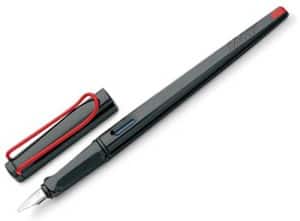 Need a great art pen for your cartoon work? See my review on 5 different pens that I have ‘road tested’ right here…
Need a great art pen for your cartoon work? See my review on 5 different pens that I have ‘road tested’ right here…

